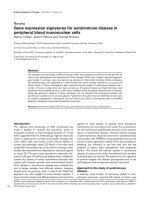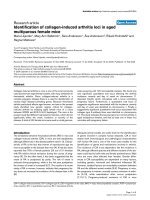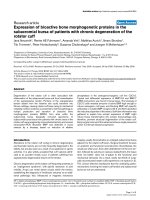Báo cáo y học: "Heparin-induced thrombocytopenia during renal replacement therapy in the intensive care uni" potx
Bạn đang xem bản rút gọn của tài liệu. Xem và tải ngay bản đầy đủ của tài liệu tại đây (40.49 KB, 2 trang )
Page 1 of 2
(page number not for citation purposes)
Available online />Abstract
Whereas some 30% to 50% of patients admitted to the intensive
care unit develop thrombocytopenia during their stay, the
incidence of heparin-induced thrombocytopenia (HIT) remains low,
at around 0.3% to 0.5%. Lasocki and colleagues prospectively
tested patients with premature clotting of the hemofiltration circuit
for HIT, and reported a 25% incidence of HIT, particularly if the
circuit clotted within 6 hours. By switching the anticoagulant from
heparin to danaparoid, the hemofiltration circuit survival and urea
clearances improved. HIT should therefore be clinically suspected
if extracorporeal circuits clot repeatedly.
The diagnosis of heparin-induced thrombocytopenia (HIT)
depends upon clinical suspicion and laboratory testing.
Unfortunately only a limited number of laboratories in the
world are now capable of performing the gold-standard
platelet serotonin release assay to determine whether the
antibodies are pathogenic. Most laboratories, as with Lasocki
and colleagues [1], therefore rely on commercially available
enzyme immunoassays (EIAs) – which have a high sensitivity
due to a high negative predictive value, but have variable
specificity as they also detect IgA and IgM antibodies, which
are probably not pathogenic [2]. Functional assays of platelet
aggregation are therefore often used to confirm EIA results.
Heparin binds to surface-bound platelet factor 4 (PF4) and,
although used as an anticoagulant, paradoxically causes
platelet activation. When patients are first exposed to
heparins, therefore, typically there is a mild fall in the
peripheral platelet count [3]. If patients are exposed to a
critical amount of heparin, a stoichiometric ratio of 27 IU
heparin to 1 mg PF4, then cross-linking of surface-bound PF4
leads to conformational change and to the exposure of novel
epitopes, with the potential to form pathogenic IgG
1
anti-
bodies to the heparin/PF4 complex. Fortunately, the inci-
dence of HIT remains low in the intensive care unit (0.3% to
0.5%) [4], probably because most patients do not receive
sufficient heparin to achieve the critical ratio to lead to novel
epitope exposure. Using an initial priming solution containing
10,000 IU heparin, followed by a heparin infusion, may
therefore have accounted for the increased incidence of HIT
(8%) reported [4]. Heparin/PF4 antibodies occur most
commonly following cardiac and vascular surgery, when
patients receive large doses of heparin intraoperatively [5].
The clinical sequalae of developing heparin/PF4 antibodies
detected by EIA varies widely [6] – ranging from being totally
asymptomatic to repeated clotting of the extracorporeal circuit
[7], to increased venous thrombosis at the sites of indwelling
central venous catheters [8], and to sudden collapse due to
pulmonary emboli or pseudopulmonary embolus syndrome
following intravenous heparin administration [9].
This disparity between the detection of heparin/PF4
antibodies by EIA and the clinical sequalae has led to the
concept of separating HIT from heparin-induced thrombo-
cytopenia and thrombosis (HITTS), and some authors have
questioned the reliability of EIAs in detecting pathologically
relevant antibodies [2]. EIA optical density results have been
compared recently with the gold-standard platelet serotonin
release; taking a 50% serotonin release as a positive
heparin/PF4 antibody result, this corresponded to an EIA
optical density ≥1.4 [10]. Even so, in Lasocki and colleagues’
study, the optical density EIA results were not greater in the
two patients with thrombotic complications, and there was no
correlation between EIA results within the HIT-positive group
with thrombocytopenia or circuit clotting [1]. Heparin
administration and dosing, and also the presence of other
antibodies – including those directed to platelet cytokines
and other surface receptors – and platelet activation may
therefore be important in determining clinical outcomes.
Commentary
Heparin-induced thrombocytopenia during renal replacement
therapy in the intensive care unit
Andrew Davenport
Royal Free and University College Medical School, UCL Centre for Nephrology, Hampstead Campus, Rowland Hill Street, London NW3 2PF, UK
Corresponding author: Andrew Davenport,
Published: 30 June 2008 Critical Care 2008, 12:158 (doi:10.1186/cc6914)
This article is online at />© 2008 BioMed Central Ltd
See related research by Lasocki et al., />EIA = enzyme immunoassay; HIT = heparin-induced thrombocytopenia; PF4 = platelet factor 4.
Page 2 of 2
(page number not for citation purposes)
Critical Care Vol 12 No 3 Davenport
Once HIT is clinically suspected it is imperative that all
heparin administration is withdrawn [11], including heparin
catheter locks and flushes [9], and another systemic
anticoagulant is substituted [12]. Patients in this series were
successfully anticoagulated with danaparoid [12], and not
only did hemofilter circuit survival increase but so did urea
clearances. This observation would suggest that the patients
with HIT had increased platelet and thrombus deposition
within the hemofilter, therefore causing membrane fouling and
reduced clearances [13]. Interestingly, circuit survival and
clearances were better for the HIT-positive group
anticoagulated with danaparoid, compared with the HIT-
negative group who remained on heparin. This difference may
have been due to so-called heparin resistance associated
with reduced antithrombin in the HIT-negative patient group.
The increased incidence of EIA heparin/PF4 antibodies
reported in the present study was probably due to the larger
doses of heparin used in priming the hemofilter circuit, and
heparin exposure should therefore be minimised in the
intensive care unit to reduce the incidence of HIT. The 4T
(thrombocytopenia, timing, thrombosis, and other causes)
pre-test probability scoring system did not predict which
patients with early hemofiltration circuit clotting subsequently
had positive EIA tests for HIT antibodies (Table 1). Whereas
previous patient series have suggested early circuit clotting
was associated with vascular access problems, the present
study showed that heparin/PF4 antibodies caused clotting
within the hemofilter, and that danaparoid was a more
effective extracorporeal anticoagulant than heparin in the HIT-
negative group. HIT should therefore be considered in cases
of very early or repeated circuit clotting.
Competing interests
AD has received travel bursaries to attend international
scientific meetings from Orgaron.
References
1. Lasocki S, Piednoir P, Ajzenberg N, Geffroy A, Benbara A,
Montravers P: Anti-PF4/heparin antibodies associated with
repeated hemofiltration-filter clotting: a retrospective study.
Crit Care 2008, 12:R84.
2. Parker RI: Measurement of heparin dependent platelet anti-
bodies in the diagnosis of heparin induced thrombocyto-
penia: fact or fiction? Crit Care Med 2007, 35:1784-1785.
3. Davenport A: Heparin induced thrombocytopenia during renal
replacement therapy. Hemodial Int 2004, 8:295-303.
4. Selleng K, Warkentin TE, Greinacher A: Heparin induced throm-
bocytopenia in intensive care unit patients. Crit Care Med
2007, 35:1165-1176.
5. Charif R, Davenport A: Heparin-induced thrombocytopenia: an
uncommon but serious complication of heparin use in renal
replacement therapy. Hemodial Int 2006, 10:235-240.
6. Warkentin TE: Clinical picture of heparin induced thrombo-
cytopenia. In Heparin Induced Thrombocytopenia. Edited by
Warkentin TE, Greinacher A. 3rd edition. Basel: Marcel Dekker
Inc.; 2004:53-106.
7. Davenport A: Management of heparin-induced thrombo-
cytopenia during continuous renal replacement therapy. Am J
Kidney Dis 1998, 32:e1-e5.
8. Hung AP, Cook DJ, Sigouin CS: Central venous catheters and
upper extremity deep venous thrombosis complicating
heparin induced thrombocytopenia. Blood 2003, 101:3049-
3051.
9. Davenport A: Sudden collapse during haemodialysis due to
immune mediated heparin induced thrombocytopenia.
Nephrol Dial Transplant 2006, 21:1721-1724.
10. Warkentin TE, Sheppard JI, Moore JC, Sigouin CS, Kelton JG:
The quantitative interpretation of optical density measure-
ments using PF4 dependent enzyme immunoassays. J Thromb
Haemost May 17 2008 [Epub ahead of print].
11. Davenport A: Intradialytic complications during haemodialysis.
Hemodial Int 2006, 10:162-167.
12. Keeling D, Davidson S, Watson H, on behalf of the Hemostasis
and Thrombosis Task Force of the British Committee for Stan-
dards in Hematology: The management of heparin induced
thrombocytopenia. Br J Haematol 2006, 133:259-269.
13. Davenport A: Anticoagulation options for patients with
heparin-induced thrombocytopenia requiring renal support in
the intensive care unit. Contrib Nephrol 2007, 156:259-266.
Table 1
The 4T (thrombocytopenia, timing, thrombosis, and other causes) pretest probability of heparin-induced thrombocytopenia [6]
Score
21 0
Acute thrombocytopenia 20 to 100 x 10
9
/l, at least 30%, 10 to 19 x 10
9
/l, any 30% to <10 x 10
9
/l, or any < 30% fall
or any 50% fall 50% fall, or > 50% fall post
cardiac surgery
Timing of fall in platelet count or Clearly 5 to 10 days (or ≤1 day 5 to 10 days but not clear (or ≤ 4 days, with no prior heparin
thrombosis or other sequalae if previous heparin given for ≤1 day if previous heparin for exposure
< 30 days) 31 to 100 days), or >10 days
Thrombosis or other clinical New thrombosis, skin necrosis, Progressive or recurrent None
sequalae or acute systemic reaction thrombosis, erythematous
post intravenous bolus skin lesions
Other cause for thrombocytopenia No other explanation Possible other cause evident Definite other cause present
High total score, 6 to 8 (HIT very likely); intermediate total score, 4 to 5; and low total score 0 to 3. Timing = first day of exposure to heparin,
counted as day 0.









